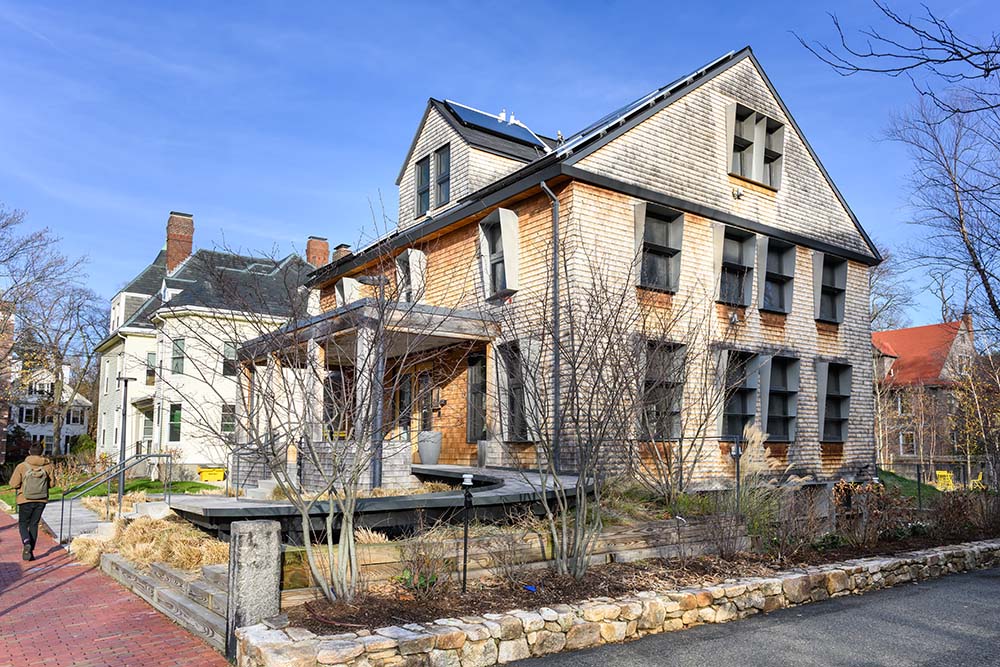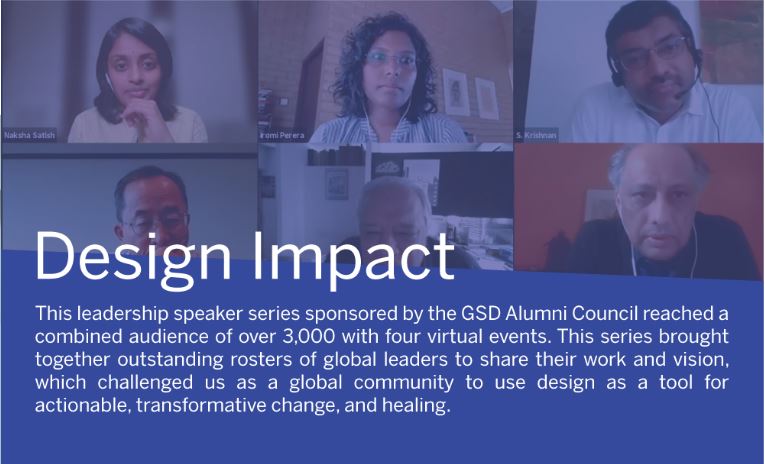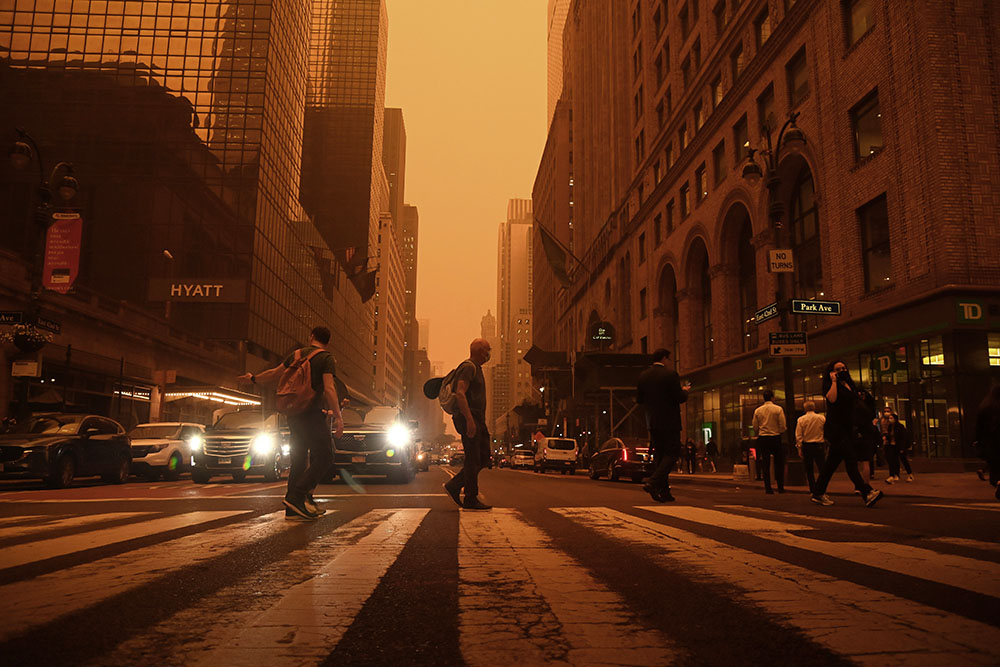How Designers Can Help Keep Our Air Breathable
Smoke from wildfires raging in Canada blanketed the Northeastern United States this month, turning the skies an eerie orange. Responding to record-setting levels of pollution, officials around the region declared health emergencies. Advice to close windows and run air filters helped mitigate the acute effects of the short-term crisis, but the event also drew attention to how climate change is intensifying chronic air pollution around the world.
Ensuring the safety and quality of air is now an urgent issue for designers. Holly Samuelson, Associate Professor in Architecture at the Harvard Graduate School of Design (GSD), is changing how the design fields think about the complexities of air quality. Protecting inhabitants from outside pollutants is only one part of the challenge. Buildings also need to have proper ventilation and provide efficient heating and cooling systems that could lower the emissions driving climate change in the first place. Samuelson shared her insights with William Smith, editorial director at the GSD.
William Smith: With this wildfire smoke offering a possible glimpse into a future of more frequent disasters stemming from climate change, what are some possible solutions the design fields could offer?
Holly Samuelson: With good design, buildings can be more airtight when desired to keep out smoke and other pollutants. As a bonus, reducing unwanted air leakage also increases thermal comfort during the winter and tends to be one of the most effective energy-saving measures in buildings. Improved airtightness requires good window selection and architectural detailing, especially at corners and joints between materials. There’s room for advancement here. It also requires a well-constructed building, so architects often specify air leakage limitations to be verified with on-site testing.
Of course, a more airtight building then requires better protection against indoor sources of pollution (If you give a mouse a cookie . . .) So, during periods of acceptable outdoor air quality, which is most of the time in many places, this means bringing in outdoor air to flush indoor pollutants, carbon dioxide, and airborne pathogens, a topic that needs little introduction since the onset of COVID. Design solutions are definitely needed here. How can we achieve the health benefits of more fresh air without all the carbon penalties of heating, cooling, and dehumidifying this air, moving it around, and constructing these systems in the first place? Cue the genius designers!
So what strategies have been used in buildings?
In Harvard’s Center for Green Building and City’s HouseZero , a naturally ventilated lab building, windows open automatically in response to measured air quality conditions. In buildings like the Chesapeake Bay Foundation Philip Merrill Environmental Center or the Artist for Humanity Epicenter, simple lights alert occupants when it’s a good time to open windows. Architects then design for good buoyancy or cross ventilation when they want to move abundant fresh air naturally.

Design teams also use energy recovery ventilation to allow heat and humidity exchange between incoming and outgoing air and to promote ventilation at times when window opening may be unpopular, like in winter. This energy recovery can be via heat exchangers, enthalpy wheels, or with small, ductless, through-the-wall units. Some design researchers are also working on passive versions of these systems, and others are advancing ultra-efficient radiant systems that focus on heating or cooling people rather than air in the first place.
Filtration is also an important topic that gains increased attention during wildfires. For buildings without mechanical ventilation, occupants can use standalone air filtration. Since pressure moves air through filters, and the higher the filtration efficiency, like MERV (minimum efficiency reporting value) 13 or HEPA (high efficiency particulate air) filters, the more air pressure that’s needed, and that takes fan power. Therefore, in mechanically ventilated buildings, designers can choose efficient equipment and remove other pressure losses in the system to avoid adding even more fan loads, for example by allowing for straight air paths with minimal surface area for friction. (Think boba tea straw, rather than curly straw for a thick milkshake.) This strategy takes space planning early in the design.
What other considerations should architects account for when creating efficient, ventilated buildings that also protect against pollution?
If we expect building occupants to close windows in unhealthy outdoor air conditions and to open windows in unhealthy indoor air conditions (a frequent problem in unventilated buildings), then issues of thermal comfort and safety matter, especially in residential buildings. This is especially important for occupants who are physiologically more sensitive to indoor overheating and poor air quality, such as young children and older adults. Architectural strategies like good sun shading, including trees, envelope insulation, and thermal storage, can reduce energy use while significantly extending the length of time that a building can remain comfortable in extreme weather conditions and power outages, an increasing concern with climate change.
The Power of a Worldwide Design Community

During an unprecedented time, the Harvard GSD Alumni Council created Design Impact, a leadership series that emphasized design as a tool for transformative change and healing.
Design’s power has always been most potent when its practitioners can come together. In the early days of the pandemic, though, the world was folding into small, quarantined boundaries. That moment revealed two things to the Harvard Graduate School of Design Alumni Council: we need practical, actionable design solutions to solve our global challenges now more than ever, and we need to do it together.
Out of that spirit, Design Impact
was born. This global design leadership speaker series brought together outstanding rosters of global leaders to share their work and vision, challenging the worldwide design community to use the field and its knowledge base as tools for transformative change and healing.
“In a time that is requiring us to meet challenges that are unprecedented, our goal was to create communities of leadership where people can lead with who they are, from where they are, with what they can,” said Ana Pinto da Silva (MDes ’05), the Design Impact co-chair and CEO of 2G3R Inc., which designs homes and communities for people of all ages and abilities. “We want to foster and support a community of leaders—as many as we can. That’s what will help at this point.”
The reach and diversity of the GSD alumni community—who they are, where they are, and what they can do—translated to a wide range of highly relevant topics with engaging speakers and discussions. Members of the Alumni Council settled on what they saw as the most urgent global issues: equity, homelessness, climate change, community and innovation, health, and resilience.
Design Impact also became the perfect platform to allow us to partner with many other Harvard Alumni Councils or associations and professional organizations. It is one step toward creating One Harvard.
Peter Coombe (MArch ’88), Alumni Council Chair
“We realized early on that we could leverage virtual meetings to engage far more members of the design community than we had ever had in the past,” said Alumni Council Chair Peter Coombe (MArch ’88). “Over the course of the five volumes of Design Impact, we registered nearly 10,000 participants from more than 100 countries. Design Impact also became the perfect platform to allow us to partner with many other Harvard Alumni Councils or associations and professional organizations. It is one step toward creating One Harvard.”
“We were bold and ambitious,” said Sameh Wahba (MUP ’97, PhD ’02, KSGEE ’13), who serves at The World Bank. “We were sending the message to the alumni that during a pandemic, the worst wave of racism, the crisis of climate change—design has a role to play.”
As Pinto da Silva put it, Design Impact was a labor of love. Numerous GSD Alumni Council members volunteered their time, partnering with the school and its students to create a series that was free and open to all. The events were volunteer-driven, and speakers appeared at no cost, as they were motivated by the importance of this series and the topics it covered.
Jaya Kader’s (MArch ’88) sessions focused on climate change , with an emphasis on radical sustainability and regeneration . Those aspects dovetailed with her work as founder and principal of KZ Architecture, a Miami-based full services design studio committed to design excellence and sustainable building practices. Hundreds of people tuned in to the panel on regenerative economics and language, which featured Indigenous leaders.
“It was transformational,” Kader said. “With regenerative design, you look at whole systems. You rethink everything that we’re conditioned to think and look at actualized potential.
“The power of design is to envision and create new worlds. That’s what we do,” she added. “We need the right brain, the creativity, the creators, the artists, the designers to come up with solutions.”
GSD students also had an opportunity to moderate and curate the sessions, as Naksha Satish (MAUD ’22) did for an event centered on South Asia
. She happened upon the event by chance: she filled out a Google form expressing her interest in participating, which she saw as reflecting the Design Impact theme of democracy in design.
“It was a great way to see the GSD family that exists beyond the school. After being associated with the Design Impact group for more than a year, it really feels like a family,” Satish said. “It was also a good way to segue from the academic perspective to look at the same topics from the practice perspective and engage with current practitioners who had a similar academic trajectory. You can understand the broad ways in which you can think of yourself as a practitioner, and you connect with the fraternity now in different ways.”
The intergenerational, transdisciplinary connections between alumni and students quickly grew into Pinto da Silva’s most treasured moments of Design Impact. “When someone in their seventies is working with someone in their early twenties, that’s powerful. You need to step aside. The stuff that comes out is so important,” she said. “The more we partner, the more we can expand our reach and be in service to our different constituencies.”
All in all, the series reached a combined audience of more than 3,000 with four virtual events
in FY21. The series culminated in September 2021 with a two-day virtual summit titled “Design Impact Vol. 5: Following the Sun: Design Futures at the Intersection of Health, Equity and Climate Change Virtual
.” The idea for this round-the-clock event, spanning time zones and reaching every corner of the GSD community, came from similar summits that Wahba had attended in his position as a global director at the World Bank. Through this summit, the final Design Impact transcended regional and national boundaries to unite the global community of practice.
Coming out of the events, 83 percent of attendees were able to identify actionable tools they could incorporate in their professional practice. That practical perspective resonated with John Friedman (MArch ’90) and his wife, Alice Kimm (MArch ’90), who curated sessions about homelessness. The couple are co-founders of John Friedman Alice Kimm Architects (JFAK), which they established in 1996 in Los Angeles based on a “common desire to create architectural environments that are simultaneously joyful, meaningful, and sustainable.”
“The GSD is shifting with the times and being less high-design and more globally focused on justice and equity,” Friedman said. “People in other countries are dealing with this stuff every day: trying to find clean water, basic shelter, dealing with incredible extremes of wealth and poverty. With Design Impact, there’s a lot of good info and sharing across cultures, which is really valuable.”
The Alumni Council is strategizing how to best share the volumes of information that came out of Design Impact and exploring how to strengthen this real-world bridge across disciplines, demographics, GSD Alumni, students, and the school. In the meantime, those who took part in Design Impact are celebrating how it brought the GSD community together in a challenging year—and provided avenues on how design can overcome those obstacles.
“This continues as a forum to express ideas for how we use design for transformation in the world,” Kader said. “The message that Design Impact brought will carry on for years to come.”
To learn more about Design Impact, click here
. Event recordings are available on the GSD’s YouTube Channel
.
